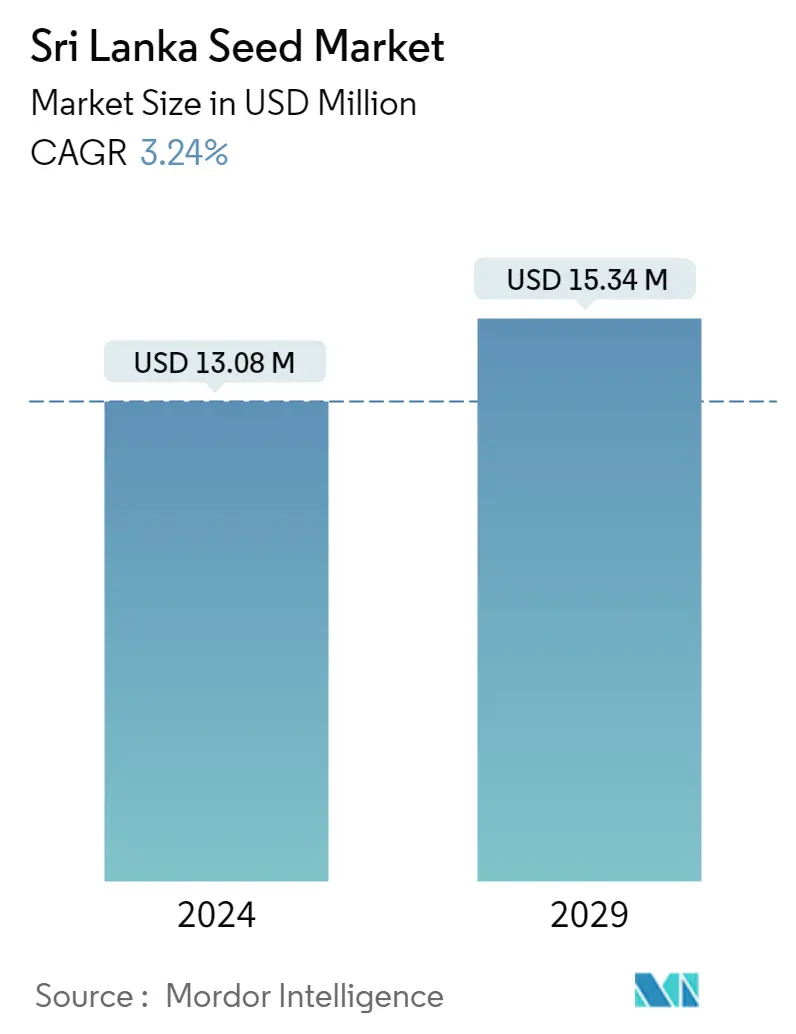Market Size of Sri Lanka Seed Industry

| Study Period | 2019 - 2029 |
| Base Year For Estimation | 2023 |
| Market Size (2024) | USD 13.08 Million |
| Market Size (2029) | USD 15.34 Million |
| CAGR (2024 - 2029) | 3.24 % |
| Market Concentration | Low |
Major Players
*Disclaimer: Major Players sorted in no particular order |
Sri Lanka Seed Market Analysis
The Sri Lanka Seed Market size is estimated at USD 13.08 million in 2024, and is expected to reach USD 15.34 million by 2029, growing at a CAGR of 3.24% during the forecast period (2024-2029).
- In Sri Lanka, seed production activities are dominated by the public sector, notably the Department of Agriculture's Seed and Planting Material Development Centre. Most of the quality seed in the country is imported and distributed to farmers by the private sector. As Sri Lanka is dependent to a large extent on imported seed, in the past year, the Department of Agriculture and Lal Teer Seed of Bangladesh implemented a project to increase vegetable seed production in the country. Furthermore, the country has chosen a sui generis system for plant variety protection.More and more, it's important to protect the rights of plant breeders with good laws, which would encourage more private companies to get involved.
- Moreover, the increasing production of cereal crops and vegetables in the country and the growth in the area under harvest of these crops have resulted in the growth of the market and hence driven the market forward in the country.
- According to the Food and Agriculture Organization Corporate Statistical Database, the cereal production in the country has increased by 12.3% in 2020, reaching 5.4 million metric tons, and the area under harvest has increased by 12.1%, accounting for 1.1 million hectares in 2020. Similarly, the country's vegetable production volume was 1.3 million metric tons during the same year, which was an increase of nearly 50% from the previous year. Variation in cereal and vegetable production necessitated the use of quality seed to ensure consistent production and productivity.
Sri Lanka Seed Industry Segmentation
A seed is the unit of reproduction of a flowering plant, capable of developing into another such plant. For the purpose of this report, the seeds used for sowing have been considered for market estimations and forecasts. The market does not include seeds used for human or animal consumption. The Sri Lanka Seed Market is Segmented by Product Type (Hybrid (Transgenic and Non-Transgenic) and Open Pollinated), Crop Type (Grains and Cereals (Rice, Maize, Soybean, and Other Crop Types), and Vegetables (Tomatoes, Pumpkin, Squash and Gourd, Chillies and Peppers and Other Vegetables). The report offers market estimation and forecast in value (USD million) and volume (Metric Ton) for the above-mentioned segments.
| Product | ||||
| ||||
| Open Pollinated |
| Crop Type | ||||||
| ||||||
|
Sri Lanka Seed Market Size Summary
The seed production industry in Sri Lanka is primarily driven by the public sector, with significant contributions from the Department of Agriculture's Seed and Planting Material Development Centre. Despite this, the private sector plays a crucial role in importing and distributing quality seeds to farmers. The country's reliance on imported seeds has led to initiatives like the collaboration between the Department of Agriculture and Lal Teer Seed of Bangladesh to boost local vegetable seed production. The adoption of a sui generis system for plant variety protection aims to enhance the rights of plant breeders, encouraging greater private sector involvement. The market is further propelled by the increasing production of cereal crops and vegetables, alongside the expansion of harvest areas, which underscores the necessity for quality seeds to maintain consistent agricultural productivity.
Sri Lanka's diverse agro-climatic conditions support the cultivation of numerous vegetable varieties, making them a vital component of the local diet and an important export product. The country is a net importer of vegetables, yet it continues to supply a variety of crops globally, benefiting from its fertile soils and established agricultural infrastructure. The seed market is characterized by a fragmented landscape with numerous local players, including Tropical Seeds/OPEX Holdings, CIC Agri-Business, and Hayleys Agriculture, who are actively investing in product development and expansion. The demand for high-quality seeds, particularly for rice and vegetable crops, is driven by both domestic consumption and export potential, with rice being a staple food for the majority of Sri Lankans. The government's focus on enhancing rice production through improved seed varieties highlights the critical role of seeds in the country's agricultural sector.
Sri Lanka Seed Market Size - Table of Contents
-
1. MARKET DYNAMICS
-
1.1 Market Overview
-
1.2 Market Drivers
-
1.3 Market Restraints
-
1.4 Porter's Five Forces Analysis
-
1.4.1 Threat of New Entrants
-
1.4.2 Bargaining Power of Buyers
-
1.4.3 Bargaining Power of Suppliers
-
1.4.4 Threat of Substitute Products
-
1.4.5 Intensity of Competitive Rivalry
-
-
-
2. MARKET SEGMENTATION
-
2.1 Product
-
2.1.1 Hybrid
-
2.1.1.1 Transgenic
-
2.1.1.2 Non-Transgenic
-
-
2.1.2 Open Pollinated
-
-
2.2 Crop Type
-
2.2.1 Grains & Cereals
-
2.2.1.1 Rice
-
2.2.1.2 Maize
-
2.2.1.3 Soybean
-
2.2.1.4 Other Crop Types
-
-
2.2.2 Vegetables
-
2.2.2.1 Tomatoes
-
2.2.2.2 Pumpkin, Squash, and Gourd
-
2.2.2.3 Chillies and Peppers
-
2.2.2.4 Other Vegetables
-
-
-
Sri Lanka Seed Market Size FAQs
How big is the Sri Lanka Seed Market?
The Sri Lanka Seed Market size is expected to reach USD 13.08 million in 2024 and grow at a CAGR of 3.24% to reach USD 15.34 million by 2029.
What is the current Sri Lanka Seed Market size?
In 2024, the Sri Lanka Seed Market size is expected to reach USD 13.08 million.

